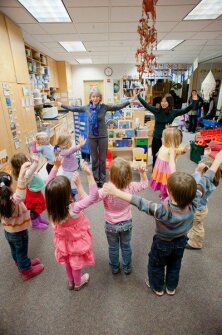
Scientists want to make kindness as integral to the curriculum as reading or math.
Researchers at University of Wisconsin-Madison’s Center for Healthy Minds have created a “kindness curriculum” which they have tested in six schools in that city. The curriculum is available online for free and has so far been downloaded 7,300 times.
Twice a week for 20 minutes during pilot testing of the curriculum, pre-kindergartners did activities aimed at helping them to pay attention, regulate their emotions, and practice kindness. Past studies have shown that children who learn these skills tend to become healthy adults who continue their education and end up financially stable. The skills may also better equip them to deal with future life stress.
“There is so much research that shows that these skills learned early in life can set kids out on a positive trajectory,” associate scientist Lisa Flook told Education Week. She is part of the team of researchers at the University of Wisconsin center that wrote and tested the curriculum. Starting early pays off, Flook said, in that for every dollar spent on early intervention, the return ranges from between $7 and $11.
Teaching Kindness
So how do teachers bring kindness into the classroom? One activity involving “peace wands” helps students settle a conflict—say, over a toy—peacefully. The child with the heart wand speaks “from the heart,” while the child with the star wand acts as the “star listener.” After the child with the heart wand expresses her feelings (“I’m sad in my heart. I want to play with the toy.”), the child with the star wand repeats back what was said (“You are sad and want a turn with the toy”). The two then switch wands and roles. The goal, in the end, is for the kids to come up with a way to solve the problem, perhaps by taking turns.
Another activity directs kids to add a sticker to a “kindness garden” poster whenever they act kindly or when a classmate acts kindly toward them. “The idea is that friendship is like a seed, it needs to be nurtured and taken care of in order to grow,” wrote Flook along with the center’s former outreach specialist Laura Pinger, who has a background as a speech and language therapist and was the main writer of the kindness curriculum. “Through that exercise, we got students talking about how kindness feels good and how we might grow more friendship in the classroom.”
Managing Emotions
In order for kids to use the peace wands effectively and take part in the kindness garden activity, they need to learn to manage their emotions. To that end, they are often asked to pay close attention to their bodies and emotions, learning eventually to control them. During the activity, “Belly Buddies,” kids listen to music while lying on their backs with a small stone resting on their stomachs. Teachers guide them to pay close attention to the way the stone feels as it rises and falls with every breath.
“It’s something that’s so simple and it allows them to experience internal quietness and a sense of calm,” said Flook.
The “Belly Buddies” activity was one that Flook and Pinger presented to writers, producers, and educators at the Sesame Street Workshop in New York City to help shape the spring 2017 season emphasizing kindness. (A 2016 survey on kindness administered by Sesame Workshop revealed that teachers and parents fear “the world is an unkind place for children.” Sesame Workshop CEO Jeffrey D. Dunn said he hoped the survey would start a national conversation about kindness.)
Another activity the pair presented at the Sesame Street Workshop is the “mind jar,” which kids make themselves by filling a clear glass jar with water and adding glitter and a drop of liquid soap. In this activity, kids shake up their handmade glitter globes and pay careful attention to the sparkly bits as they slowly begin to settle, just as their minds settle down eventually after they’ve become upset.
Study Results
Researchers tested the children in sharing, attention, and empathy before the program began and after it ended. The results show that participants improved in each area, as well as in their grades, when compared with the control group.
The researchers measured children’s sharing through a task that involved divvying up stickers. There were four trials. Children were given a set of 10 stickers in each trial and asked to put them in one of two envelopes, one marked “ME,” and the other bearing a picture of a particular recipient (someone the child identified as a peer they like to play with, a peer they don’t like to play with, a child who is sick, and a stranger). Children could donate or keep as many stickers as they wanted. Their sharing was measured by averaging the number of stickers shared across the four trials.
The children’s attention was measured by using a computer-based task while empathy was measured by teacher reports of students’ social behavior. Grades came from end-of-year report cards. You can read the full study here.
The pilot study was small: 30 pre-kindergartners went through the 12-week kindness program, while data from 38 other pre-kindergartners were used as a comparison. Flook said the results show the curriculum’s potential, though larger studies are needed to demonstrate the curriculum’s success over the long term.
Photo: Associate scientist Lisa Flook (right) and former outreach specialist Laura Pinger (left) teach the Center for Healthy Minds Kindness Curriculum to preschoolers at the Waisman Center Early Childhood Program at University of Wisconsin-Madison. In addition to exploring prosocial concepts like kindness, forgiveness and gratitude, kids are taught mindful movement exercises to build awareness of their minds and bodies.(William Graf)
Related stories: